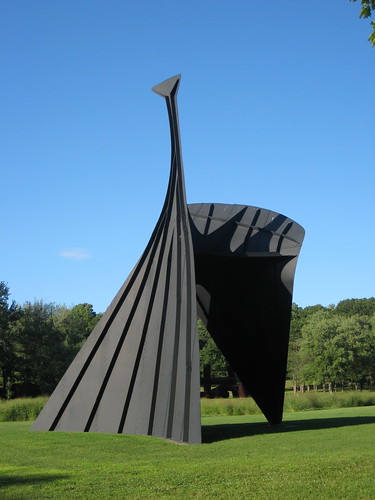
I think my two-year-old made his first interpretation of art on Saturday. We drove up to Storm King Art Center in the Hudson Highlands because it was a beautiful day and a holiday weekend and a sculpture park is the perfect way to keep both parents and toddler happy. Nothing but grass and big indestructible beasts, like this 1975 Alexander Calder, titled “The Arch”. It sits in a mowed circle in a field of wildflowers and grasses, so your approach, down a grass path, is oblique. It is hard to see how the sculpture hits the ground. As we were walking toward it I told my son it was a sculpture (he already knows what a statue is from our trip to the Saint-Gaudens Historic Site) and then I asked him, “What does it look like?” He said, still running towards it, “Airplane!” Exactly.
I am not sure he noticed any of the other sculpture, since soon after that sublime moment of parental pride, he spotted the tram. “Tram! Tram! Tram!” for the next three hours.
The adults did manage to pay attention to a few other works. Richard Serra’s “Schunnemunk Fork” (1990-91) has settled in nicely, its steel plates extending from the soft hillsides with a stealthy violence that offers a nice contrast to the general tone of the large-scale works at Storm King: graphic, tectonic, apolitical. The thought that occurred to me as we walked over hill and down dale, was how wonderful the Calders and di Suveros looked on the rolling grasslands and how odd a place it was for them to end up. I think of all these sculptors (and Saint-Gaudens too) as urban types, with an urban clientele, forging pieces for the city. The Calders I have appreciated most in situ are those most hemmed in by architecture: “Flamingo” in the courtyard at Mies’s Federal Center in Chicago; “Black Beast” in the courtyard at Eliot Noyes’s own house in New Canaan, CT. The beasts push metaphorically on the glass boxes at their backs. Out in the grass their outlines look sharper but their movement is stilled, so they operate more like grotesquely overscaled garden ornaments. Saint-Gaudens’ “Diana”, so impudent atop Madison Square Garden, is merely another nymph in the country.
The only work that was new to us was Maya Lin’s “Wavefield” (2009), an 11-acre, seven-range set of artificial hills, designed by the architect to mimic the shape and size of ocean waves in dirt. It photographs beautifully, looking much like a Hiroshi Sugimoto photograph in color, but in person it was somewhat underwhelming. Because it is so new, you aren’t allowed to walk between or over the waves, only around the edge, so it feels like a dollhouse version of the bigger, unsculpted hills in the rest of the park, tidy and arid. There’s nothing to experience (yet). The indoor exhibition of other recent Lin sculpture also felt arid, as if she were putting on an taking off the garb of any number of contemporary sculptors. An indoor wooden version of the waves reminded me of Ursula von Rydingsvard with less oomph, or Tara Donovan with less mystery (and jokes). We saw more interesting pin art at the Saint-Gaudens site, by Claire Watkins.
The only object that seemed really new was a wall relief, “Chesapeake”, the outline of the bay in recycled silver. The material has a mixed metallic tone and the curving edges suggest surface tension on a pool, as if the fingery form had been quickly drawn with a stick in water. That sensation of speed was what was missing from the rest of the pieces, which seemed to drain their natural forms of the spark of life.

